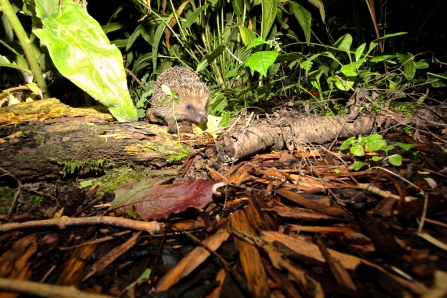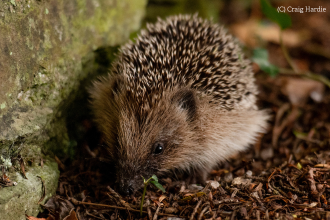This week’s Wild Cornwall article is from the latest issue (Spring - Issue 141) which was sent to members last week. We might take hedgehogs for granted as they are such a familiar creature from story books – and, in recent years, internet videos – but when was the last time you actually saw one in the wild? In this article, find out more about this wonderful little creature and their secret superpowers!

Martin Yelland
Beyond their charismatic cuteness, there's a lot to discover about these wonderful little creatures and their secret superpowers!
We might take hedgehogs for granted as they are such a familiar creature from story books – and, in recent years, internet videos – but when was the last time you actually saw one in the wild?
Hedgehogs attract a lot of interest in the press these days because of their dwindling numbers, but what about some of the facts that make these animals so interesting in the first place?
We shouldn’t overlook the well documented population decline but let’s first learn something about these nocturnal mammals. To understand why they are so important to our native ecosystems, why we should aim to protect them, and how we can influence changes, would be taking a big step towards helping our local hedgehog population to recover.

(c) Hedgehog, Craig Hardie
The earliest known member of the hedgehog family lived about 58 million years ago. Hedgehogs have always fascinated people and this dates back to the Neolithic Period – proof of which exists in the form of a carved toy hedgehog that was found buried next to a grave, unearthed near Stonehenge, dating back some 3,000 years. There are now seventeen species of hedgehog in five genera found through parts of Europe, Asia, and Africa. The smallest hedgehog that ever existed was a species called Silvacola acares that lived 52 million years ago in the rainforests of northern British Columbia. It was about 2 inches long. All species are now extinct in the Americas – possibly due to their small size.
Slightly more recently… hedgehogs were actually domesticated by the Romans, who were well known for adapting European mammal species for all sorts of things including food, weapons and clothing. As a result of Roman conquests throughout England, we now have species such as rabbits and ‘edible’ dormice (Glis glis) in our countryside.
Cornish hedgehogs have long enjoyed a largely undisturbed existence, unlike their cousins elsewhere in Roman Britain, who lived in fear of having a spine or two nabbed for use as quills, or worse, ending up as a tasty snack in a centurion’s lunchbox!
A prickly situation
The facts indisputably show that hedgehogs are amazing animals that have been around for many millennia and we want this to continue. But more importantly, and the reason behind the alarm at their population decline, they are an ‘indicator’ species – the foraging equivalent of the coal-mine canary for our environmental health.
If hedgehogs exist in a habitat, then all the food they eat lower down the food chain must also exist to sustain them. They must be able to access other areas in which to breed and keep the population going. However, habitat fragmentation, farming, garden pesticides and the hedgehog’s unfortunate susceptibility to becoming roadkill are the biggest threats to hedgehogs and has resulted in a significant population decline. In fact, it’s statistically likely that the last hedgehog you saw was lying dead at the side of the road. This sobering fact is one that we want to change by helping these creatures – and the ecosystems that they represent – to become part of the countryside, our gardens, and Cornwall’s wildlife again.
Unfortunately, no superpower can save hedgehogs without human intervention. Cornwall Wildlife Trust, alongside our partners the Cornwall Mammal Group and Prickles and Paws Rescue Centre, is part of Operation Hedgehog, which is working to understand where hedgehogs still exist in Cornwall – and where they are absent. We aim to build this population back up to strength with local initiatives to reverse the population decline across the county.
12 hedgehog facts and threats
- There are between 5,000 and 7,000 spines on an average adult hedgehog.
- Hedgehogs can climb very well. Obstacles such as stone-faced earth banks (e.g. Cornish hedges) and even small garden brick walls are easy going for them.
- In Cornwall and milder parts of the UK, instances of pregnancy reach a peak between May and July, and then again in September. The latter breeding attempt making them vulnerable to losses over winter.
- Other hedgehog superpowers include their super speed – they can run at speeds of up to six feet per second – that’s four miles an hour, which is pretty impressive for their size!
- While defending territories, hedgehogs emit snorts, squeals and grunts – just like pigs – hence the ‘hog’ part of their name. Shakespeare mentions hedgehogs in The Tempest and A Midsummer Night’s Dream as ‘hedgepigs’ as well as ‘urchins’ due to their spiny exterior.
- They also eat reptiles, particularly juvenile snakes – hedgehogs are highly resistant to adder venom! A protein called erinacin in the hedgehog’s muscular system has healing properties that prevent a blood haemorrhage if bitten by an adder. This provides effective armour should they accidently disturb a resting adder during their nocturnal activities.
- Hedgehogs have the ability to camouflage themselves from predators. They do this by licking certain objects or food until a frothy saliva forms, then rubbing the saliva onto their skin and spines, which is believed to make them smell less palatable to predators.
- Hedgehogs are omnivores and make the most of the countryside larder with a diet that includes insects, berries, birds' eggs, mushrooms, mice and amphibians.
- A hedgehog’s spines are shed under certain circumstances. Much like humans and their milk teeth, young hedgehogs outgrow their baby spines, which are gradually replaced by adult ones as they develop.
- The Cornish name for hedgehog is ‘sort’. This word is also used for 'sea urchin' due to their shared spiny appearance.
- Hedgehogs, along with dormice and bats, are the only British mammals that hibernate, although they may become active during mild winter periods.
- A hedgehog’s behavioural response to perceived threat (especially noise) is to roll into a ball, which unfortunately offers very little protection against the cars and lorries on our roads and strimmers in our gardens.


